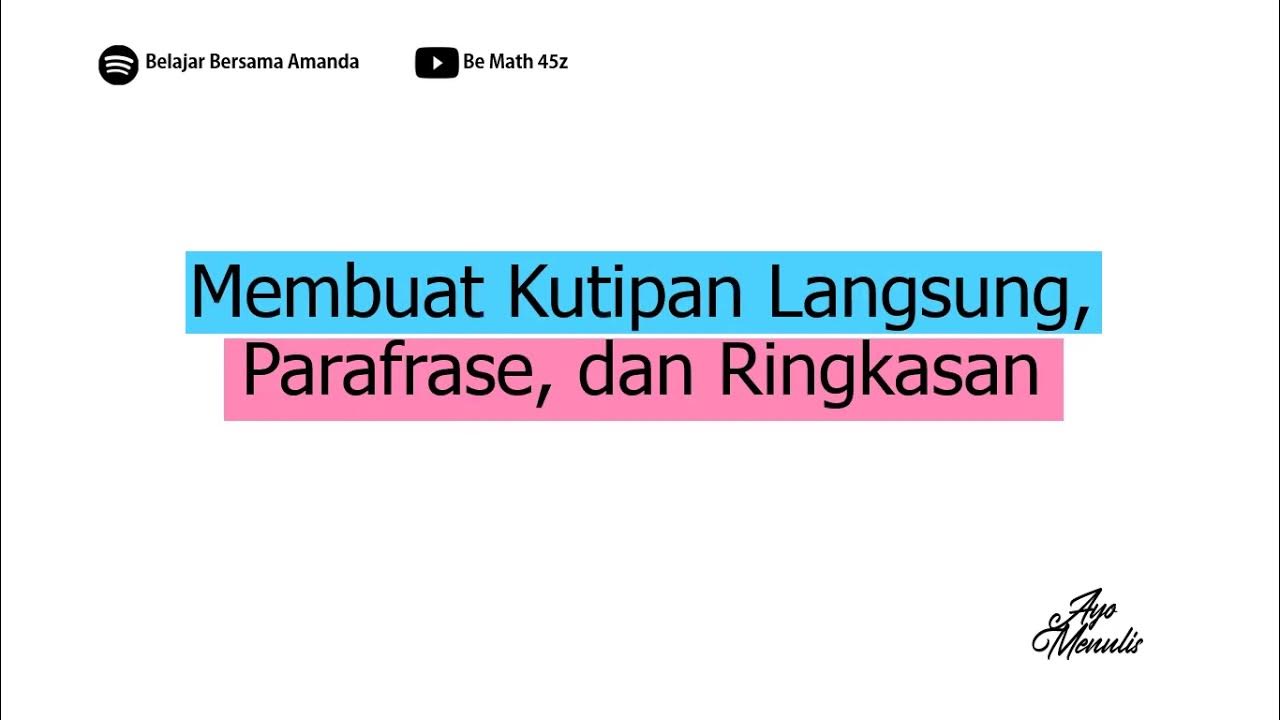CARA MENULIS KUTIPAN
Summary
TLDRThis video explains the importance of mastering quoting techniques, especially for writing Chapter 2 of academic papers. The focus is on understanding direct and indirect quotes, as well as the differences between footnotes and endnotes (badinot). It covers how to write quotes, avoid plagiarism, and the significance of paraphrasing to maintain the message while changing the wording. The video also highlights practical tips for incorporating quotes into theoretical sections and ensures the proper use of citation styles. The goal is to prepare viewers to effectively integrate quotes into their writing while adhering to academic standards.
Takeaways
- 😀 Mastering the process of writing quotes is essential before proceeding with Chapter 2, particularly for the theoretical basis section.
- 😀 A quote is defined as taking one or more sentences from another source to strengthen arguments or provide illustrations in your own writing.
- 😀 Footnotes are placed at the bottom of the page and provide detailed source information, while endnotes (badinots) are placed within the text itself in a more concise form.
- 😀 Direct quotes must be exactly as they appear in the original source, while indirect quotes can paraphrase the original material while retaining the same message.
- 😀 Short direct quotes are quotes with fewer than four lines, while longer quotes require special formatting and placement in the text.
- 😀 Indirect quotes are preferred over direct quotes because they help avoid plagiarism detection systems by paraphrasing the original text.
- 😀 Indirect quotes must change the form of the original writing but must keep the core message intact to avoid plagiarism.
- 😀 The key difference between footnotes and endnotes lies in the placement of the citation information—footnotes are at the bottom of the page, while endnotes are within the text.
- 😀 The format of footnotes includes full source information, whereas badinots (endnotes) are more concise and are typically placed directly within the text.
- 😀 Indirect quotes allow for flexibility and can change the structure of the original text, making them more convenient for writing and reducing the risk of being flagged for plagiarism.
- 😀 It is important to understand the material thoroughly before using indirect quotes to ensure that the paraphrased content accurately conveys the original message.
Q & A
Why is it important to understand how to write a quote before compiling Chapter 2?
-Understanding how to write a quote is essential because you'll need it for the theoretical basis section in Chapter 2. Mastery of quoting is necessary to present supporting arguments and properly reference sources.
What is the general definition of a quote according to the Big Indonesian Dictionary?
-A quote, according to the Big Indonesian Dictionary, refers to a levy, quotation, or citation. It involves taking a sentence or more from another written work for the purpose of illustration or argumentation.
What is the difference between a footnote and a badinot?
-A footnote is a form of quotation that places the source information at the bottom of the page. A badinot, or body note, includes additional information directly in the text itself, rather than at the page's footer.
What are the key differences between footnotes and badinots in terms of source information?
-Footnotes provide complete source information, such as the meaning of a word or a full reference, at the page's footer. Badinots, however, include concise source details within the text itself, often just the author's last name, year, and page number.
What is the primary function of a direct quote?
-A direct quote must be written exactly as it appears in the original source. Its purpose is to reinforce or illustrate the argument being presented without altering the original text.
What is an indirect quote, and how does it differ from a direct quote?
-An indirect quote involves paraphrasing or summarizing the original text. Unlike direct quotes, indirect quotes allow for changes in wording while maintaining the original message.
What is the preferred type of quote in academic writing, direct or indirect, and why?
-Indirect quotes are preferred because they help avoid plagiarism. They allow the writer to rephrase the original text while maintaining the original meaning, reducing the risk of being flagged by plagiarism detection systems.
What are short and long direct quotes, and how should they be formatted?
-Short direct quotes are no longer than four lines, while long direct quotes exceed four lines. Short quotes are embedded within the text, while long quotes are separated and indented. The formatting involves adjusting spacing and using quotation marks appropriately.
Why do people prefer indirect quotes over direct quotes?
-Indirect quotes are preferred because they are more flexible and easier to integrate into writing. They also reduce the likelihood of plagiarism detection, as they involve paraphrasing the original text rather than copying it directly.
What should be done to avoid plagiarism when using direct quotes?
-To avoid plagiarism with direct quotes, ensure that the quote is used exactly as it appears in the original source. If changes are made, ensure the meaning remains intact and properly cite the source to attribute it correctly.
Outlines

This section is available to paid users only. Please upgrade to access this part.
Upgrade NowMindmap

This section is available to paid users only. Please upgrade to access this part.
Upgrade NowKeywords

This section is available to paid users only. Please upgrade to access this part.
Upgrade NowHighlights

This section is available to paid users only. Please upgrade to access this part.
Upgrade NowTranscripts

This section is available to paid users only. Please upgrade to access this part.
Upgrade NowBrowse More Related Video

How to Paraphrase in 5 Easy Steps | Scribbr 🎓

PDD-UKTPT Bidang Pengajaran | Muhammad Nur | Politeknik Negeri Fakfak

KARYA ILMIAH MATERI BAHASA INDONESIA KELAS 11 LENGKAP

Cara Mengutip untuk Menghindari Plagiat: Parafrase, Kutipan Langsung, dan Rangkuman

7 Tips Menulis Karya Ilmiah Bahasa Arab Yang Benar Di LAPTOP / merubah baris footnote ke kanan

EAW (11) Writing a paragraph
5.0 / 5 (0 votes)